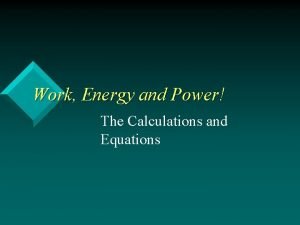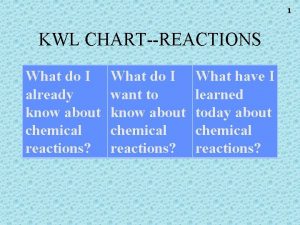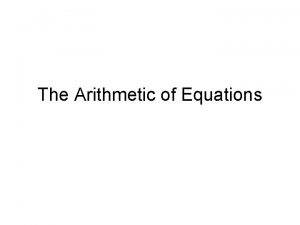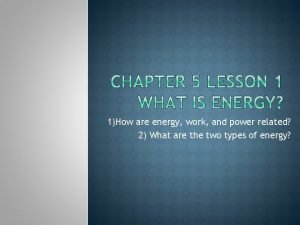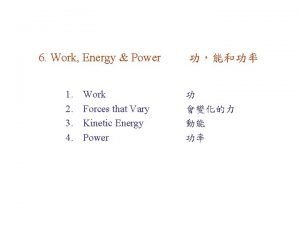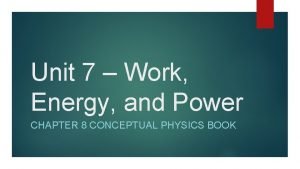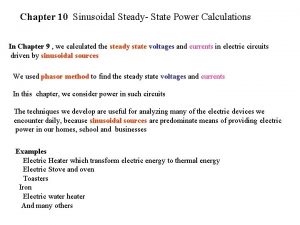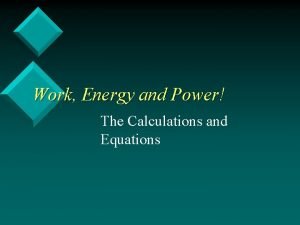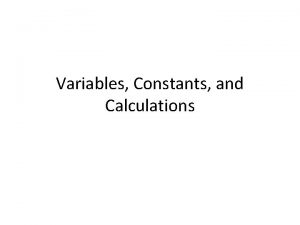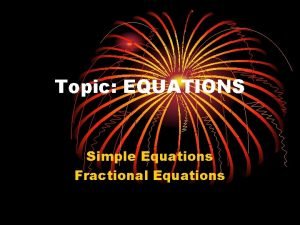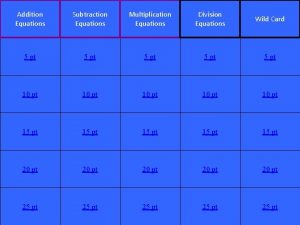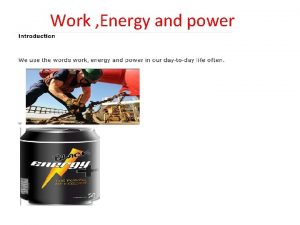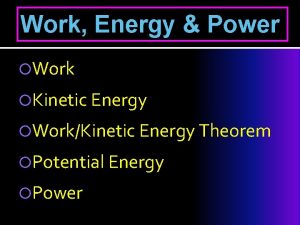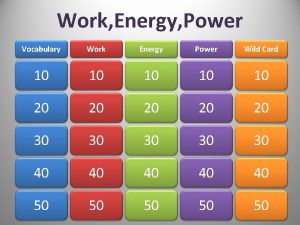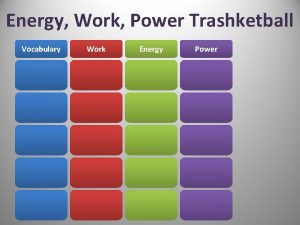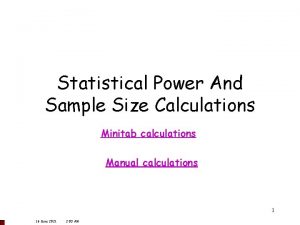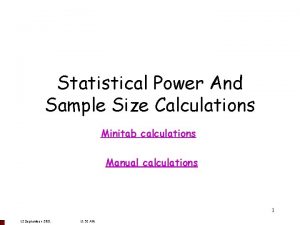Work Energy and Power The Calculations and Equations














- Slides: 14

Work, Energy and Power! The Calculations and Equations

James Joule • British physicist James Joule is best known for his work in electricity and thermodynamics Together with the physicist William Thomson (later Baron Kelvin), Joule found that the temperature of a gas falls when it expands without doing any work. This principle, which became known as the Joule-Thomson effect, underlies the operation of common refrigeration and air conditioning systems. • The metric system unit of energy is the joule (J), after James Joule.

Mechanical • Mechanical energy is the energy which is possessed by an object due to its motion or its stored energy of position • Kinetic energy : is the energy of motion • Potential Energy : an object can store energy as the result of its position or elastic source

Work Concept • Work is defined as a force acting upon an object to cause a displacement • Mathematically, work can be expressed by the following equation. • W= F x d cos q ( cos 00 = 1) • where F = force, d = displacement, and the angle (theta) is defined as the angle between the force and the displacement vector

Work Calculations W=F x d cos 300 =100 N X 5 m =500 N m = 100 N X 5 m X. 87 = 413 N m W= F x d =15 Kg(10 m/s 2) X 5 m = 750 N m

Gravitational Potential Energy • After an object has been lifted to a height, work is done. • PE = W= F x d= mah Potential Energy is maximum at the maximum HEIGHT

Potential Energy Calculation • How much potential energy is lost by a 5 Kg object to kinetic energy due a decrease in height of 4. 5 m • PE = mah • PE = (5 Kg)(10 m/s 2)(4. 5 m) • PE = 225 Kg m 2/s 2 • PE = 225 J

Kinetic Energy Calculation • • The energy of motion DKE = W= F x d= mah=1/2 mv 2 Find the kinetic energy of an 4 Kg object moving at 5 m/s. KE = 1/2 mv 2 KE = ½ (4 Kg)(5 m/s) 2 KE = 50 Kg m 2 /s 2 KE = 50 J

Elastic potential energy

Spring constant Calculation A tired squirrel (mass of 1 kg) does pushups by applying a force to elevate its center-of-mass by 5 cm. (A) Determine the number of push-ups which a tired squirrel must do in order to do a mere 5. 0 Joules of work. (B) Determine the squirrel’s spring constant.

Spring Constant Calculation • • W = F x d = 10 N*(. 05 m)=. 5 N m W =. 5 J (each push up) 10 pushups = 5 J PE = ½ k x 2. 5 J = ½ k (. 05 m) 2. 5 J = ½ k (. 003 m 2). 5 J =. 0015 m 2 333. 3 J/m 2 = k

Power! • • Power is the rate that we use energy. Power = Work or Energy / Time P = W/t = F x d/t = F v The units for power : • J/s • Kg m 2 / s 2 /s • Nm/s

Power Calculation • A 5 Kg Cart is pushed by a 30 N force against friction for a distance of 10 m in 5 seconds. Determine the Power needed to move the cart. • P=Fxd/t • P = 30 N (10 m) / 5 s • P = 60 N m /s • P = 60 watts

Summary • Energy is the ability to move • Potential is stored energy (Statics) • Dependant on height • Kinetic is moving energy (Dynamics) • Dependant on velocity • Springs store energy dependant on distance and constant
 Work energy power equations
Work energy power equations Structural steel connection calculations calculations
Structural steel connection calculations calculations Section 4 review physical science
Section 4 review physical science Kwl chart of chemical formula
Kwl chart of chemical formula The arithmetic of equations
The arithmetic of equations Work, power and energy activities
Work, power and energy activities Definition of work done
Definition of work done How are work and power related
How are work and power related Work power energy and machines
Work power energy and machines F d cos theta
F d cos theta Work power
Work power Jenis usaha apa
Jenis usaha apa Draw the power triangle
Draw the power triangle Physics 03-02 potential energy and conservative forces
Physics 03-02 potential energy and conservative forces Sinusoidal steady state power calculations
Sinusoidal steady state power calculations
